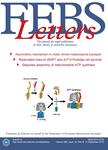版权所有:内蒙古大学图书馆 技术提供:维普资讯• 智图
内蒙古自治区呼和浩特市赛罕区大学西街235号 邮编: 010021

作者机构:Natl Univ Singapore Dept Biol Sci Singapore 117543 Singapore Natl Univ Singapore Inst Mol Agrobiol Singapore 117543 Singapore
出 版 物:《FEBS LETTERS》 (欧洲生化学会联合会快报)
年 卷 期:2002年第520卷第1-3期
页 面:139-144页
核心收录:
学科分类:0710[理学-生物学] 071010[理学-生物化学与分子生物学] 081704[工学-应用化学] 07[理学] 08[工学] 0817[工学-化学工程与技术]
基 金:National University of Singapore NUS
主 题:zebrafish basic helix-loop-helix basic domain neurogenesis neuron isl-1
摘 要:In zebrafish, the basic helix-loop-helix (bHLH) gene neuroD specifies distinct neurons in the spinal cord. A preliminary experiment indicated that a related bHLH gene, ndr1a, normally expressed only in the olfactory organ in late embryos, also functions as neuroD to induce ectopic formation of spinal cord neurons in early embryos after introduction of its mRNA into early embryos. To define the functional specificity of these bHLH proteins, several mutant forms with selected point mutations in the basic domain were constructed and tested for inducing sensory neurons in the spinal cord. Our data indicate that the functional specificity of NeuroD to define sensory neurons is mainly due to a single residue (asparagine 11) in its basic domain. (C) 2002 Published by Elsevier Science B.V. on behalf of the Federation of European Biochemical Societies.